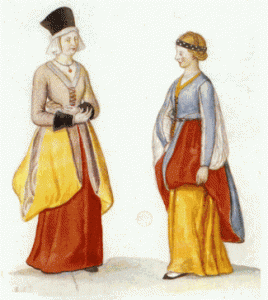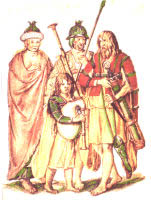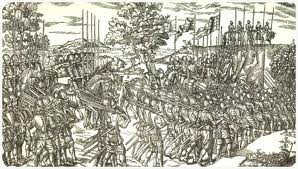Ellen MacCarthy – The Survivor
John Dorney looks at the life of Ellen MacCarthy, who survived the Tudor conquest of Gaelic Ireland. And her marriage.

It is a fact that most of recorded history concerns the actions of men. Roughly half the population – women – until very recently left very little written trace of their existence.
This is as true of Ireland as of anywhere else in the late 16th century. This does not mean they had no power however. The life of Ellen MacCarthy, or Eilean Ni Carthaigh as she would have been known at the time, gives us a glimpse into how an aristocratic Gaelic Irish woman managed to uphold her own interests.
She not only negotiated her way through the introduction of the English state into Gaelic Ireland and the upheavals of the Nine Years War but also through the perils of her unhappy arranged marriage and inter-clan politics.
Ellen MacCarthy was member of a class that was undermined and largely displaced by the Tudor conquest of Ireland. Her Gaelic Irish culture was denigrated and sidelined. As a women, she was married off strategically at the age of 14 and endured an unhappy marriage to a man who was often absent in England pursuing his land claims.
But she was no helpless victim. Her husband, Florence MacCarthy ended up imprisoned for life in London, his lands split up between English settlers and rival MacCarthys. Ellen MacCarthy did not go down with him. Quite the contrary, she helped to bring about his downfall and ended the 17th century with an English grant of land in Munster.
An aristocratic birth
Ellen MacCarthy was born in what is now county Cork, the daughter of Donal MacCarthy Mór – chief of the MacCarthy clan of modern south Cork and Kerry – in about 1574.
Ellen MacCarthy was arranged to be married at 14 to one Nicholas Browne, but her father’s followers and wife objected
[1] She would have had much more privileged upbringing than virtually everyone else in Ireland, apart from fellow members of the aristocratic elite. She was brought up in MacCarthy castles and attended to by servants. Her childhood was short though. By the time she was 14, she had become a pawn in a power struggle over the ownership of the MacCarthy lands.
Not far to her north was the MacCarthy Reagh lordship, the second, or táiniste, of which was Florence MacCarthy. The two MacCarthy lordships (there were in fact two more) had had differing fortunes in the Desmond rebellion (1579-1582). The MacCarthy Mor lordship supported the Fitzgerald dynasty in failed their rebellion against the English administration. The MacCarthys Reagh had backed the English.
After the rebellion was put down, the lands of the Fitzgeralds and their allies were seized and granted to English and Scottish settlers in the Munster Plantation. (You can read about the MacCarthys and the plantation here).
Shortly after the end of hostilities in the Desmond war, Donal MacCarthy Mór’s legitimate son, fled to France, having been suspected of rebellion, where he died shortly afterwards, leaving MacCarthy Mór (Earl Clancarthy) without a legitimate male heir.
Equally significantly, MacCarthy Mór mortgaged some of his lands, perhaps as a result of losses incurred during the fighting, or perhaps, as some English officials claimed, to finance his indolent lifestyle. The end result was that he lost some land at Mollahiffe to Valentine Browne of Lancashire and his family, who had been denied a grant of land in Desmond in the plantation[2].
Under traditional Gaelic practice, the inheritance of the lordship would have been open to a wide panel of relatives of the incumbent, derbh fine or “true kin”. One of the effects of the English state’s establishment in Ireland, was the imposition of primogeniture or the inheritance of land by the first born son. On the death MacCarthy Mor’s legitimate son, as his land and title were held by English patent (as “Earl Clancarthy”) inheritance would pass to the husband of his daughter Ellen.
‘A bitter discontentment’ – the marriage of Florence and Ellen

Ellen MacCarthy’s marriage, therefore, would determine who inherited Desmond, the main MacCarthy lordship. It was Warham St Leger, the English Lord President of Munster, who first alerted London to the disquieting implications of her proposed marriage. In a letter to the Privy Council in May 1588, St Leger reported that Clancarthy had promised his daughter to Nicholas Browne (son of the undertaker, Valentine) for money.
This had, ‘wrought generally in these parts a bitter discontentment’ as, ‘there is nothing the Irish more esteem than the nobility of blood, preferring it far before either virtue or wealth, so they abhor nothing more than disparagement, being more odious to them than death’. It was not that Nicholas Browne was English that the MacCarthys seem to have objected to, but that he was of low-born, non-aristocratic lineage.
Ellen herself, her mother Lady Clancarthy and ‘diverse gentlemen of the country’ had come to complain about her marriage to such a commoner, and, unless she, ‘was matched to someone of a noble house’, her mother threatened to hide her in O’Rourke’s country (in modern County Leitrim)[3].
As a result of his wife and kinsmen’s anger, MacCarthy Mor instead promised Ellen to Florence MacCarthy to ‘to continue the house in the name’. St Leger went on to highlight the dangers of this to the English interest. He pointed out that Florence was already in line to be tainiste of Carberry and was related to the MacCarthys of Muskerry, the Fitzmaurices and the Roches, and would inherit a huge estate and following as MacCarthy Mór;
‘How perilous that may be to make him so great, together with the alliances before recited, and the alliance he is like to have by this marriage by which all the Clan Carthys are to be at his devotion. ‘If he should become undutiful…of which, although there be good hope to the contrary, yet what ill council he may do, he being greatly addicted to the brute sort of those remote parts’.
Ellen’s mother had her married in secret to Florence MacCarthy, a man of noble lineage, landed and Catholic
Even worse than being ‘greatly embraced’ by the natives, he was also (in this year of the Spanish Armada) ‘much addicted to the company of Spaniards’, had learned the Spanish language and was, ‘fervent in the Old Religion’ which was why the Lady Clancarthy (Ellen’s nother) favoured him over Browne[4].
The marriage between Ellen and Florence took place in secret, with a Catholic ceremony, and O’Sullivan Mór as witness[5]. St Leger argued that in order to prevent the formation of a large, armed Irish lordship, which could only undermine the plantation and English government in Munster, it was better to use pre-emptive force rather than to be caught unawares in the event of rebellion or Spanish invasion.
Thomas Norreys, the vice-president of Munster, summoned Florence to Limerick on July 1 to explain his actions. He did not trust the young MacCarthy and did not believe his offer to forfeit his inheritance, ‘those words being so contrary to that which he often did attempt’[6] Norreys held Florence and Ellen in custody along with Lady Clancarthy as a precaution. He also promised further arrests, including O’Sullivan Mór[7]. Florence was temporarily held in the custody of the Protestant Bishop of Cork – William Lyons. Such was the fear of invasion and Irish rebellion, that harsh treatment was given to many Munster lords in late 1588.
What did the 14 year old Ellen make of her marriage to the 28 year old Florence? The short version is that we don’t know. But her mother had especially supported the match and at this age she probably did not have the maturity or the independence to make her own judgement. Marriage at that age to us seems like a form of child abuse, but it was quite common in, not only the Gaelic, but the European aristocratic world.
In any case, it does seem as if Ellen herself was, at least initially, a willing participant. She escaped from custody in February 1589, after St Leger threatened to disallow the marriage, ostensibly due to Ellen being underage. She took refuge in Carberry with ‘a man of the said Florence’s’ Brian na Carda” (Brian of the cards). St Leger, suspecting that Florence was hiding her until she came of age, promptly sent Florence to the Tower of London in June 1589 and confiscated his bond of £400 and Castle Lough[8].
On May 14th 1590, Florence wrote to Burghley, Elizabeth’s chief secretary, claiming that Clancarthy wanted to marry his wife Ellen to Nicholas Browne against her will, and petitioning to let her live openly and not to let the Earl, ‘offer her any wrong or molestation’. He also asked that no one who had hidden her should be ‘troubled for the same’[9].
Florence must have been persuasive, because the following December, the Privy Council instructed the Lords Justices of Ireland not to confiscate the lands or castles of Florence’s followers, to release their hostages and return their goods as Ellen had appeared in Cork[10].
The following month, Florence was released to live within 3 miles of London, on a bond of £1000 paid by the Earl of Ormonde. Ellen joined him shortly afterwards.
‘Like a young prince’
While in London, Florence’s wife Ellen gave birth to their first son in 1592. Florence wrote to Burghley asking for a maintenance grant, while he was denied access to his landed income and a protection against being arrested for debt[11]
Ellen MacCarthy and her young son were sent home to Carberry, where, as the Bishop of Cork reported, ‘Finian’s’ child, ‘after the country manner is used among the people as a Young Prince, carried about the country with three nurses and six horsemen…and happy is he that can foster him for a month!…[he is sent] from month to month to the best of the family to be fostered with such songs of rejoicing and praise of his father Finian [Florence] and the young imp’[12]. Geoffrey Fenton, Secretary of State for Ireland, commented that the treatment of the child showed, ‘an inward pretence to raise an extraordinary greatness to the parents and to draw a multitude of followers’[13]
Elizabeth I seems to have taken a better view of the young Irishman however. In November 1593, Florence was allowed to return to Ireland. He spent much of the next five years back and forth to London, lobbying for the right to be allowed to inherit all the MacCarthy Mor lordship (or as the English saw it, the Earldom of Desmond).
Ellen MacCarthy must have seen little enough of him. But she saw enough, after having her first child at the age of 18, to have three more of Florence MacCarthy’s children. The marriage had been decided for strategic reasons and not for love and it was not long before the sheen came off thier relationship. In 1594, Nicholas Browne, to whom Ellen had once been promised, reported that Florence and Ellen were, ‘at variance’ and separated over, ‘whether his men or hers should inhabit my lands’.
In 1599, Florence wrote to London complaining of trouble with his wife who thought, ‘I am trying to take away her inheritance’. It was after all, Ellen, not Florence who was of the MacCarthy Mor line.
‘Not minded to go a-begging’

In the Nine Years War of 1595-1603, Florence MacCarthy tried to use both the Irish forces under Hugh O’Neill and those of the English to secure his right to inherit Desmond. (A full article on that subject is here).
In trying to achieve this objective, he found his enemies piling up. The English governor in Munster, George Carew took an instant dislike to him and in any case judged his command over the MacCarthy clans to be too much of a security risk to allow him to inherit the lands he wanted. To curb his power in the locality, Carew recruited Donal MacCarthy, Ellen’s half brother – the late MacCarthy Mor’s illegitimate son to hunt Florence.
This left Florence with the choice of submitting to the English or openly joining the rebel forces. One of the reasons he did not take the latter option was Ellen MacCarthy.
According to English sources, she had been passing on secret information about her husband to Wilmott, the Governor of Kerry, and who, ‘compelled him to [submit]; for she had refused to come to his bed until he had reconciled himself to Her Majesty, saying that she knew in what manner her father had held his Earldom for Her Highness; and … she [wanted] to obtain some part thereof; but if neither of these could be got, yet she was not minded to go a-begging either into Ulster or Spain’.[14]
‘She hath ever understood and repugned the undutiful courses of her husband’, George Carew on Ellen MacCarthy
This tells us a number of things about Ellen MacCarthy. Firstly she considered herself an independent woman, who should inherit part of her father’s land and not cede it to her husband. Secondly, although excluded from formal political power, her control over her husband’s sex life gave her a formidable power over him – an element of all relationships throughout history perhaps. Thirdly, she was used to a comfortable life and ‘would not go a-begging’, in the cause either of the Catholic religion or out of animosity to the English.
We might not believe this report if it was a one off, but it was confirmed in 1602 when the lands of Florence MacCarthy, who had again been arrested and sent to the Tower of London, were divided among those who had helped the English in the war. Ellen MacCarthy, who George Carew wrote, ‘hath ever understood and repugned the undutiful courses of her husband’ was designated for a grant of land and money. [15]
‘That wicked woman that was my wife’
The marriage of Florence and Ellen MacCarthy had a bad ending.
‘I have sent away that wicked woman that was my wife…whom I saw not nor could abide in almost a year before my commitment’, Florence MacCarthy on his wife.
Florence himself was committed to the Tower with James Fitzthomas. Robert Cecil, the Chief Secretary found that he had ‘protection’ for all of his known crimes and therefore, ‘we must only make him a prisoner by discretion’.[16] In other words, he would be held indefinitely without charge, and therefore could be held as long as the authorities felt was necessary. Although the terms of his imprisonment were relaxed over the years, Florence would never return to Ireland and died in London in around 1640.
Florence brought up his four sons in London, presumably with the help of his retainers there, although his eldest son died there not long after Florence’s arrest.[17] His estrangement from his wife however was final. In 1607 he reported that he had sent away, ‘that wicked woman that was my wife…whom I saw not nor could abide in almost a year before my commitment [imprisonment]’[18].
Ellen was eventually granted 13 quarters of land and £150 a year, which was to be left to her sons, Teig, Donal, Cormac and Finian, on 16 April 1607[19].
What became of Ellen MacCarthy? The evidence contained in Florence MacCarthy’s papers dries up here. Her sons later came back to Munster but if they resumed their relationship with their mother we do not know. Perhaps she took another husband. Perhaps she was integrated into the new, anglicised landed elite.
It seems likely that she made some way for herself in the new order. She was, above all a survivor.
References
[1] Daniel McCarthy, Letter Book of Florence MacCarthy Reagh, Tanist of Carberry p.20
[2] McCarthy, Letter Book p.24, According to Irish custom, mortgaged land was occupied by the lender until the debt was repaid.
[3] St Leger to Privy Council 14 May 1588, McCarthy, Letter Book p.34.
[4] Ibid. p.30
[5] Ibid. p.31
[6] Norrys to Walsyngham, July 1 1588, McCarthy, Letter Book p.39
[7] Ibid. p.41.
[8] St Leger to Burghley, February 1589, McCarthy, Letter Book p.61
[9] Florence to Burghley, 14 May 1590, McCarthy, Letter Book p.75
[10] Privy Council to Lords Justices, 15 December 1590 McCarthy, Letter Book p.77
[11] Florence to Burghley, June 17 1592, McCarthy, Letter Book p. 81
[12] Bishop of Cork to Geoffrey Fenton, March 8 1593, McCarthy, Letter Book p. 82
[13] Geoffrey Fenton to Burghley, March 15 1593, McCarthy, Letter Book p. 86
[14] For previous (Browne to Burghley, 4 December 1594), Letter Book 123) (Florence to Cecil April 20, 1599, Letter Book p187)Stafford, Pacata Hibernia Vol. IIp.126
[15] Carew to Cecil, January 31, 1602, McCarthy, Letter Book p356.,
[16] Cecil to Carew, September 10 1601, in McCarthy, Letter Book, p. 342
[17] Florence to Salisbury, December 1608 in McCarthy, Letter Book, p.387
[18] Florence to Salisbury, June 1608, in McCarthy, Letter Book, p. 385
[19] McCarthy, Letter Book, p.374